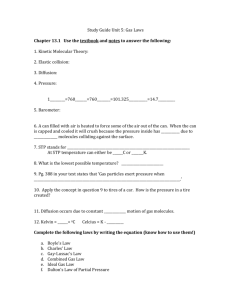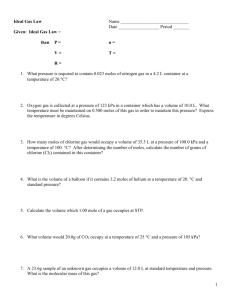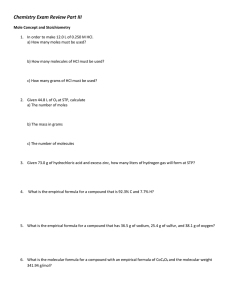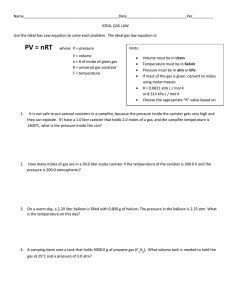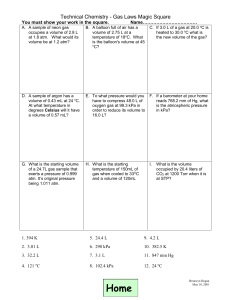Ideal Gas Law Practice Problems Worksheet
advertisement
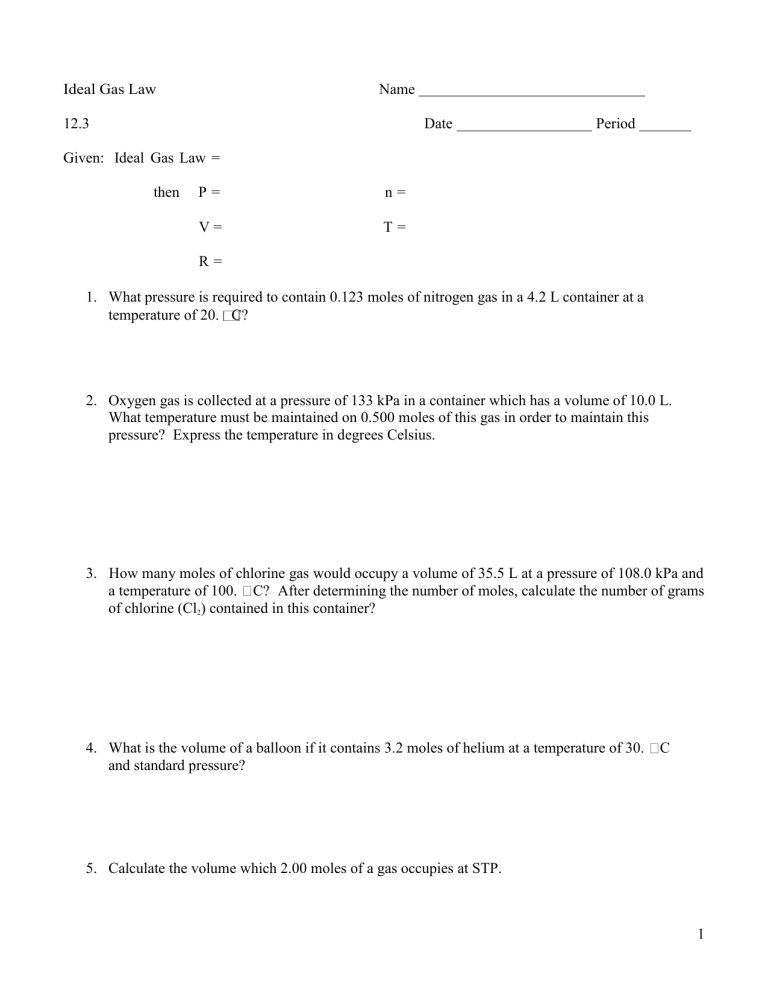
Ideal Gas Law Name 12.3 Date Period Given: Ideal Gas Law = then P= n= V= T= R= 1. What pressure is required to contain 0.123 moles of nitrogen gas in a 4.2 L container at a temperature of 20. C? 2. Oxygen gas is collected at a pressure of 133 kPa in a container which has a volume of 10.0 L. What temperature must be maintained on 0.500 moles of this gas in order to maintain this pressure? Express the temperature in degrees Celsius. 3. How many moles of chlorine gas would occupy a volume of 35.5 L at a pressure of 108.0 kPa and a temperature of 100. C? After determining the number of moles, calculate the number of grams of chlorine (Cl2) contained in this container? 4. What is the volume of a balloon if it contains 3.2 moles of helium at a temperature of 30. and standard pressure? C 5. Calculate the volume which 2.00 moles of a gas occupies at STP. 1 6. What volume would 20.0g of CO2 occupy at a temperature of 25 C and a pressure of 105 kPa? 7. A 23.6g sample of an unknown gas occupies a volume of 12.0 L at standard temperature and pressure. What is the molecular mass of this gas? 8. What mass of nitrous oxide gas (N2O) is contained in 25.0 L balloon at a pressure of 110.0 kPa and a temperature of 25 C? 9. What pressure would be required to contain 100.0 g of SO2 gas in a 25.0 L container at a temperature of 100. C? 10. What pressure would a sample of gas have if the volume is 10.0 L the number of gas particles is 0.10 moles, and the temperature is 500. Kelvin? 11. 2 12. What volume would a sample of gas have if the pressure is 8.2 atm, the number of gas particles is 2.0 moles, and the temperature is –73 degrees Celsius? 13. 22.00 g of CO2 has a volume of 50.00 L and a pressure of 0.8210 atm. What must be the temperature of the gas? 14. How many grams are in a sample of oxygen gas if the pressure is 1,520 mm Hg, the volume is 8,200 ml, and the temperature is –73 degrees Celsius? 15. Modern vacuum techniques make it possible to reach a pressure of 1.00 x 10-10 mm Hg in a laboratory system. What volume in milliliters would 1.00 x 106 molecules of gas occupy at this pressure and standard temperature? 16. What volume would be occupied by 100. g of oxygen gas at a pressure of 1.50 atm and a temperature of 25 °C? 17. 3 18. An air-filled balloon has a volume of 225 L at 0.940 atm and 25 °C. Soon after, the pressure changes to 0.990 atm and the temperature changes to 0 °C. What is the new volume of the balloon? 19. A gas confined in a 515 cm3 container exerts a pressure of 107.4 kPa at 38.6 °C. At what Celcius temperature will it exert a pressure of 635.7 kPa if it is placed into a 644 cm3 container? 20. A balloon is inflated with 0.2494 g of helium to a pressure of 1.26 atm. If the desired volume of the balloon is 1.250 L, what must the temperature be in °C? 21. A welder’s acetylene tank has a volume of 75.0 L. It is stored at a temperature of 23.24 °C and has a pressure of 7667 kPa. How many moles of acetylene are in the tank? 22. How many grams of argon would it take to fill a light bulb with a volume of 0.475 L at STP? 4 23. Dry ice is carbon dioxide in the solid state. 1.28 grams of dry ice are placed into a 5.00 L evacuated chamber that is maintained at 35.1°C. What is the pressure in the chamber in kPa after all the dry ice has sublimed into CO2 gas? 24. A sample of Br2 gas is loaded into an evacuated demonstration bottle at STP. The volume of the bottle is 0.25 L. How many moles of Br2 gas will be contained in the bottle? 25. A sample of gas occupies .308 m3 at a temperature of 325 K and a pressure of 149 kPa. Calculate the number of moles of the gas that are present. 26. What pressure is exerted by 0.625 moles of a gas in a 45.4 L container at -24.0 °C? 27. Calculate how many grams of methane (CH4) are in a sealed 800. mL flask at room temperature (22 °C) and 780. mm of pressure. 28. Calculate how many grams of hydrogen can be burned if 40. liters of oxygen at 200. K and 1.0 atm. 5 True and False: If the statement is true, write “true.” If it is false, change the underlined word or words to make the statement true. Write your answer on the line provided. 1. Real gases behave like ideal gases except at very high temperatures. 2. The gas constant, R, is equal to 0.0821 when the pressure is expressed in kilopascals. 3. As more gas particles are added to a container, there are fewer collisions because the particles don’t go as far. 4. The number of moles of a gas is inversely proportional to its volume at STP. 5. Real gases behave like ideal gases except at very high pressure. 6. At a constant temperature, the pressure exerted by one mole of a gas decreases if the volume available is increased. 7. The ideal gas equation will only give correct values if the temperature in expressed in degreesCelcius. 8. One mole of oxygen at 760. mm Hg and 0 °C occupies a volume of one L. Matching: Match each variable listed on the left with the appropriate unit of measurement listed on the right. You may write one or more letters on each line. Circle the ones used in the Ideal Gas Equation. 9. number of moles 10. volume 11. pressure 12. temperature A. °C B. kg C. mol D. mm Hg E. K F. L G. atm H. Pa I. °F J. m3 K. cm3 L. kPa M. torr 6
